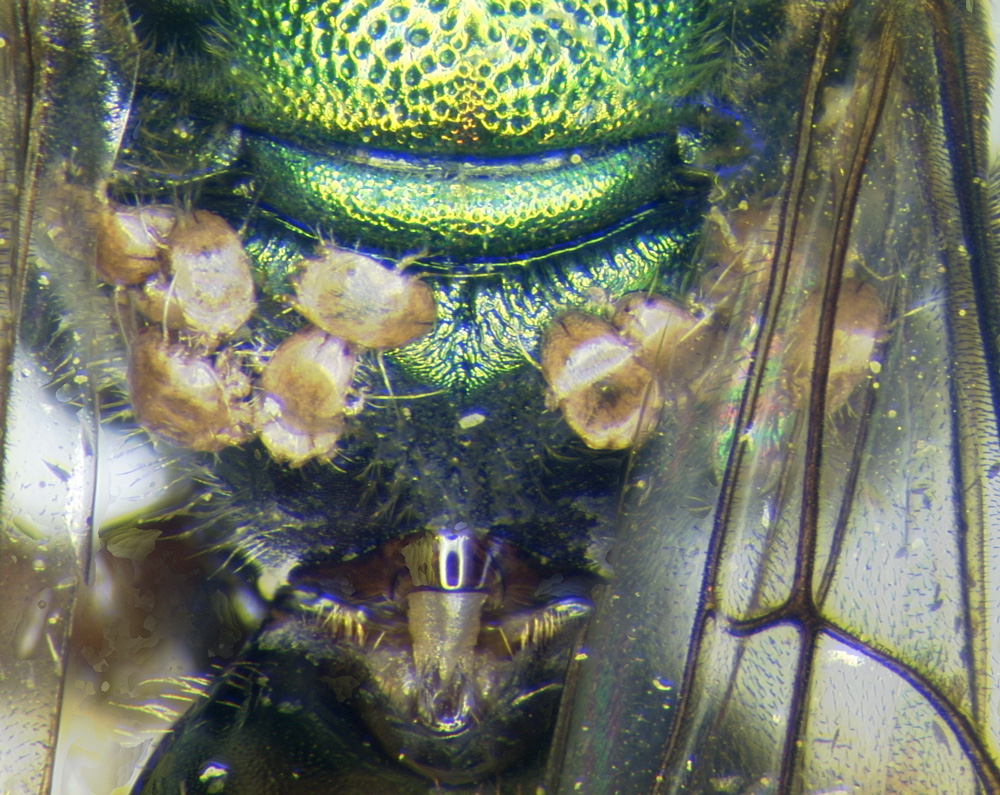Bee Mites : Acari : Acariformes : Sarcoptiformes : Chaetodactylidae : Sennertia : Sennertia species
Sennertia recondita Klimov and OConnor, 2008
Sennertia recondita Klimov and OConnor, 2008: 151, Figs 74-75.
Material (show database records). Holotype: HDN - MEXICO: Quintana Roo, Vallarta, 17 km. W Pto. Morelos, 20°30'N 87°00'W, 6 Oct 1986, T. Griswold, ex Ceratina eximia (propodeum), USNM, BMOC 96-0510-231. Paratypes: 10 HDNs - same data as holotype; 5 HDNs - same data, BMOC 96-0510-230; 7 HDNs - BELIZE: Cayo, 7 mi N of Blancaneaux Lodge, ex C. eximia (orig: C. aurata) (propodeum), 11 Jul 1973, Y. Sedman, AMNH BMOC 04-0508-276. Holotype in USNM, paratypes in AMNH, UMMZ, UNAM, USNM.
Description. Phoretic deutonymph. Gnathosomal solenidia shorter than 1/3 of femur I width, gnathosomal solenidia exceeding half of setae vi. Supracoxal setae scx situated on dorsal extension of posterior apodeme I. Hysterosomal shield distinctly expanded beyond lateral gland opening and bases of setae f2. Lateral edges of hysterosomal shield in anterior part not narrowing. Dorsal hysterosomal pouch absent. Distance between anterior margin of hysterosomal shield and setae si exceeds diameter of si bases. Striate pattern of idiosomal cuticle outside hysterosomal shield formed by long striae, with sclerotization, sclerotization shifted to posterior striae. 10-14 lines between setae se and si. Distinct rudiments of vi absent. Setae si distinctly posterior se; exceed 1/2 of se, almost as thick as se. Diameter of si exceeds 1/2 of diameter of se. Setae c1 and d1-h1 uniform in length, microsetae. Setae c1 microsetae; situated posterior to anterior margin of hysterosomal shield. Setae c3 nearly spiniform, situated on soft cuticle. Setae d1 and e1 nearly uniform in length with h1. Setae d1 situated on hysterosomal shield. Sclerite between ia and d2 absent. Setae e2 subequal with d2, not touching hysterosomal shield. Lateral gland openings situated on hysterosomal shield. Setae 4b filiform. Setae 4b, g, and 4a without distinct rhomb-like widening, filiform. Setae 4b, pR I-II, sR III, wF IV, gT I-II, hT I-II, kT III, ra I-II, and wa I-II filiform. Posterior apodemes II and anterior apodemes III free. Anterior apodemes IV not interrupted, almost straight. Posterior apodeme IV present, connected to anterior apodeme III. Additional posterior sclerite of posterior apodeme IV present. Conoids ps2 anterior to anterior transverse level of central suckers (ad1+2); anterior to ps1, situated outside outer level of ad1+2. Transparent margin of anterior suckers (ad3) without rough sclerotization. Suckers ad3 not enlarged, smaller than central suckers. Posterior and lateral borders of attachment organ not forming distinct frame. Sclerotized rudiment of anterior cuticular suckers present. Longitudinal hysterosomal sclerite present, long. Ventral hysterosoma smooth. Genual setae mG I-II bifid at tips, mG II shorter than femur II. Tarsal setae la I-II longer than famulus ε. Tarsal setae ra I-II not bifid, filiform. Tarsal setae wa I-II and s III filiform, needle-like, or widened basally but with attenuated end. Tarsal setae d I-II foliate. Tarsal setae d and f I-II almost symmetrical, d and f I not touching. Solenidion ω3 closer to f I than to ω1. Posterior condylophore present. Anterior condylophore I-II with distal bending. Seta d III situated shifted from tarsal base, distance distinctly exceeding diameter of d III alveolus. Leg IV not protruding posterior edge of hysterosoma. Tarsus IV not enlarged, shorter or less than 2 times longer than width of trochanter IV. Setae w IV thinner than d IV and distinctly shorter than leg IV, situated on middle of tarsus IV. Setae s IV present. Setae wF IV not protruding tibia IV.
Other instars unknown.
Hosts. Ceratina (Calloceratina) eximia.
Distribution (Show map). Mexico: Quintana Roo (type locality), Belize: Cayo.
Etymology. Recondita (put away, concealed) is a Latin adjective in the feminine gender.
Notes. Similar to S. surinamensis and S. sodalis. See key above for the diagnostic characters.
References
Klimov, P. B. & B. M. OConnor. 2008. Morphology, evolution, and host associations of bee-associated mites of the family Chaetodactylidae (Acari: Astigmata), with a monographic revision of North American taxa. Miscellaneous Publications Museum of Zoology University of Michigan.199: 1-243.
Image Gallery
B. OConnor and P. Klimov ©
Created: May 26, 2011
Last modified: 


